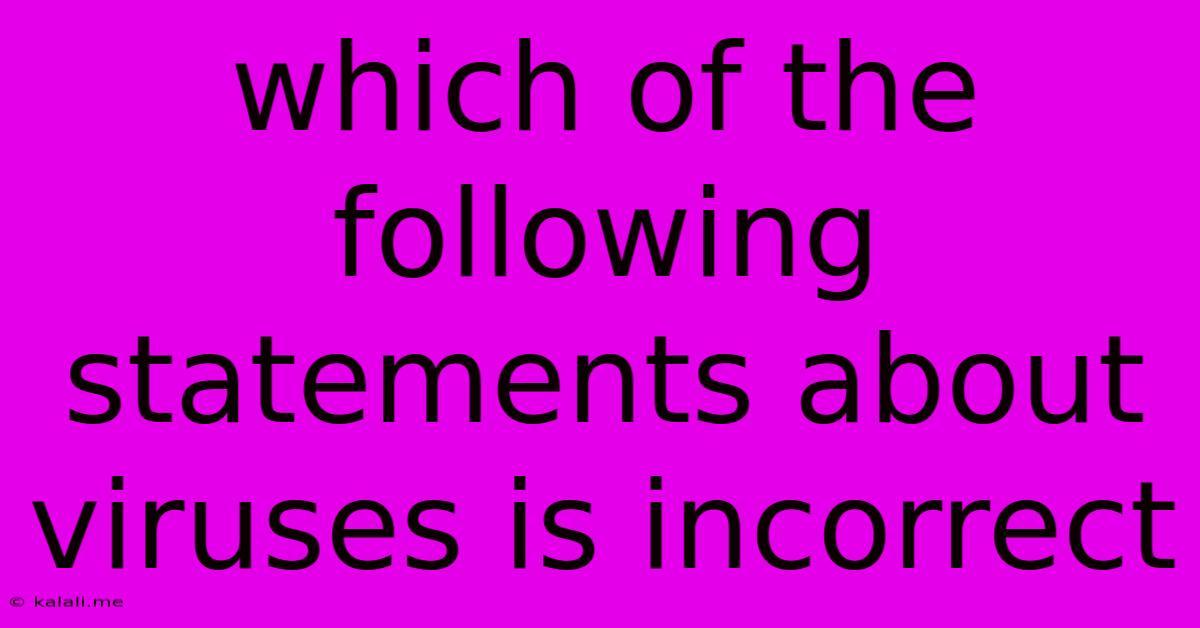Which Of The Following Statements About Viruses Is Incorrect
Kalali
Jun 13, 2025 · 3 min read

Table of Contents
Which of the following statements about viruses is incorrect? Debunking Common Misconceptions
Viruses are fascinating and often misunderstood entities. They exist in a gray area between living and non-living, leading to many common misconceptions. This article aims to clarify some of these by identifying and explaining why a particular statement about viruses is incorrect. We'll explore several characteristics of viruses, examining their structure, reproduction, and impact on host cells to pinpoint the false statement among a range of possibilities.
Understanding the Nature of Viruses
Before we dive into debunking the incorrect statement, it's helpful to establish a basic understanding of what constitutes a virus. Viruses are obligate intracellular parasites, meaning they require a host cell to replicate. Unlike bacteria, which are self-sufficient organisms, viruses lack the necessary cellular machinery for independent reproduction. They consist primarily of genetic material (either DNA or RNA) encased in a protein coat called a capsid. Some viruses also have an outer lipid envelope.
This dependence on a host cell is key to understanding their lifecycle. A virus infects a cell by attaching to its surface, injecting its genetic material, and then hijacking the cell's machinery to produce more viral particles. This process often leads to the destruction of the host cell.
Common Misconceptions and the Incorrect Statement
Several statements about viruses are commonly made, but not all are accurate. To identify the incorrect one, let’s consider these possibilities and analyze their validity:
-
Statement A: Viruses are alive. This is incorrect. While viruses exhibit some characteristics of living organisms, such as reproduction and evolution, they lack others, such as cellular structure and independent metabolism. They are considered to be on the borderline between living and non-living.
-
Statement B: Viruses can infect both prokaryotic and eukaryotic cells. This is correct. Bacteriophages, for instance, are viruses that infect bacteria (prokaryotic cells), while many other viruses infect plants, animals, and fungi (eukaryotic cells).
-
Statement C: Viruses contain both DNA and RNA. This is incorrect. While some viruses utilize DNA as their genetic material, others use RNA. However, a single virus particle contains either DNA or RNA, never both simultaneously.
-
Statement D: Viral infections can lead to the development of cancer. This is correct. Several viruses, known as oncogenic viruses, are linked to the development of certain cancers. Examples include human papillomavirus (HPV) and Epstein-Barr virus (EBV).
-
Statement E: Antiviral drugs can completely eradicate a viral infection. This statement is partially true, but the nuance matters. While antiviral drugs can significantly reduce viral load and alleviate symptoms, they rarely completely eradicate the virus from the body. Some viruses establish latency, integrating their genetic material into the host's DNA, making complete eradication challenging.
Therefore, the incorrect statements are A and C. While both statements contain elements of truth, they lack complete accuracy. Statement A is incorrect because viruses don't meet all the criteria for life, and Statement C is incorrect because viruses only contain one type of genetic material (DNA or RNA) at a time. Understanding these distinctions is crucial for a comprehensive understanding of virology.
Conclusion:
This exploration into the characteristics of viruses helps clarify common misconceptions. By identifying and explaining why certain statements are incorrect, we’ve reinforced the unique nature of these obligate intracellular parasites and their impact on various life forms. Further exploration into specific viral families and their interactions with host organisms will undoubtedly provide a richer understanding of virology's complexity.
Latest Posts
Latest Posts
-
Unit Of Overall Heat Transfer Coefficient
Jun 14, 2025
-
How To Write A Letter Requesting A Promotion
Jun 14, 2025
-
Colorado School Of Mines Acceptance Rate Out Of State
Jun 14, 2025
-
Which Of The Following Is Part Of The Hydrosphere
Jun 14, 2025
-
The Internal Resistance Of An Ideal Voltage Source Is
Jun 14, 2025
Related Post
Thank you for visiting our website which covers about Which Of The Following Statements About Viruses Is Incorrect . We hope the information provided has been useful to you. Feel free to contact us if you have any questions or need further assistance. See you next time and don't miss to bookmark.